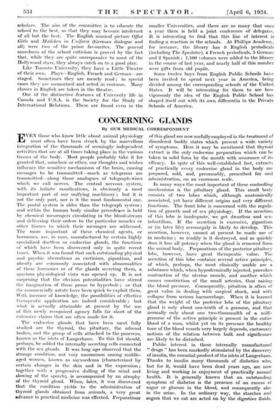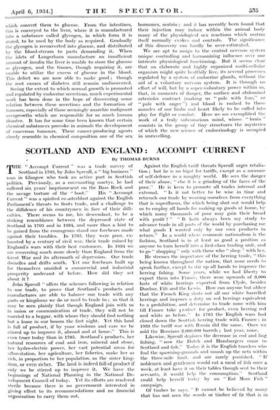CONCERNING GLANDS
By OUR MEDICAL CORRESPONDENT
EVEN those who know little about animal physiology must often have been struck by the marvellous integration of the thousands of seemingly independent activities that are at all times taking place in the various tissues of the body. Most people probably take it for granted that, somehow or other, our thoughts and wishes influence the sensitive mechanisms of the brain, causing messages to be transmitted—much as telegrams are transmitted—along those analogues of telegraph-wires which we call nerves. The central nervous system, with its infinite ramifications, is obviously a most important part of our unifying machinery ; but it is not the only part, nor is it the most fundamental one. The postal system is older than the telegraph system ; and within the human body similar precedence is held by chemical messengers circulating in the blood-stream and delivering their orders to the particular muscles or other tissues to which their messages are addressed. The more important of these chemical agents, or hormones, are, in man, manufactured by certain highly specialized ductless or endocrine glands, the functions of which have been discovered only in quite recent times. When it was found that such outstanding physical and psychic aberrations as cretinism, gigantism, and obesity are commonly associated with abnormalities of these hormones or of the glands secreting them, a spacious physiological vista was opened up. It is not surprising that the obvious potentialities have stirred the imagination of those prone to hyperbole ; or that the commercially astute have been quick to exploit them. With increase of knowledge, the possibilities of effective therapeutic application are indeed considerable ; but what is actually attainable at present by the use of this newly recognized agency falls far short of the extensive claims that arc often made for it.
The endocrine glands that have been most fully studied are the thyroid, the pituitary, the adrenal bodies, and the group of cells attached to the pancreas, known as the islets of Langerhans. To this list should, perhaps, be added the internally secreting cells connected with the sex glands. It was long ago observed that the strange condition, not very uncommon among middle- aged women, known as myxoedema (characterized by certain changes in the skin and in the expression ; together with a progressive dulling of the mind and slowing of the speech), is accompanied by an atrophy of the thyroid gland. When, later, it was discovered that the condition yields to the administration of thyroid glands obtained from animals, a very great advance in practical medicine was effected. Preparations of this gland are now usefully employed in the treatment of disordered bodily states which present a wide variety of symptoms. Here it may be mentioned that thyroid extract is the only endocrine preparation which can be taken in solid form by the mouth with assurance of its efficacy. In spite of this well-established fact, extracts of practically every endocrine gland in the body are prepared, sold, and, presumably, prescribed for oral administration, on an enormous scale.
In many ways the most important of these controlling mechanisms is the pituitary gland. This small body consists of two lobes which, although anatomically associated, yet have different origins and very different functions. The front lobe is concerned with the regula- tion of growth and of sex physiology. If the secretion of this lobe is inadequate, we get dwarfism and sex- infantilism. If the secretion is excessive, gigantism or (in later life) acromegaly is likely to develop. This secretion, however, cannot at present be made use of in medicine ; so readily is it destroyed, and so quickly does it lose all potency when the gland is removed from the animal body. Preparations of the posterior pituitary lobe, however, have great therapeutic value. The secretion of this lobe contains several active principles, of which, perhaps, the most clinically usable are a substance which, when hypodermically injected, provokes contraction of the uterine muscle, and another which causes constriction of the small arteries, thus raising the blood pressure. Consequently, pituitrin is often of great value in dealing with surgical shock, and with collapse from serious haemorrhage. When it is learned that the weight of the posterior lobe of the pituitary gland is only about one-tenth of a gramme, and that normally only about one two-thousandth of a milli- gramme of the active principle is present in the entire blood of a man, whilst yet on its presence the healthy tone of the blood vessels very largely depends, customary notions of the relation between bulk and significance are likely to be disturbed.
Public interest in these internally manufactured " drugs " has been markedly stimulated by the discovery of insulin, the essential product of the islets of Langerhans. Thanks to insulin many thousands of diabetics who, but for it, would have been dead years ago, are now living and working in enjoyment of practically normal health. It is generally known that an outstanding symptom of diabetes is the presence of an excess of sugar or glucose in the blood, and consequently also in the urine. In the ordinary way, the starches and sugars that we eat are acted on by the digestive fluids, which convert them to glucose. From the intestines, this is conveyed to the liver, where it is manufactured into a substance called glycogen, in which form it is stored, to be used by the body as required. Gradually the glycogen is reconverted into glucose, and distributed by the blood-stream to parts demanding it. When the islets of Langerhans manufacture an insufficient amount of insulin the liver is unable to store the glucose as glycogen, and the tissues, though requiring it, are unable to utilize the excess of glucose in the blood. This defect we are now able to make good ; though the root causes of diabetes still remain undiscovered.
Seeing the extent to which normal growth is promoted and regulated by endocrine secretions, much experimental work has been done in the hope of discovering some relation between these secretions and the formation of tumours, especially of those seemingly anarchic malignant overgrowths which are responsible for so much human disaster. It has for some time been known that certain chemical substances provoke in animals the development of cancerous tumours. These cancer-producing agents closely resemble in chemical composition one of the sex hormones, oestrin ; and it has recently been found that their injection may induce within the animal body many of the physiological sex reactions which oestrin itself normally evokes and controls. The significance of this discovery can hardly be over-estimated.
We are apt to assign to the central nervous system unique controlling and harmonizing influence over our intricate physiological functioning. But it seems clear that an elaborate and highly organized multi-cellular organism might quite healthily live, its several processes regulated by a system of endocrine glands, without the aid of a voluntary nervous system. It is through no effort of will, but by a super-voluntary power within us, that, in moments of danger, the surface and abdominal arterioles contract (making us " pale with fear," or " pale with anger ") and blood is rushed to those muscles of our limbs and heart likely to be called into play for flight or combat. Here we see exemplified the work of a truly subconscious mind, whose " brain " consists in the group of tiny structures the mysteries of which the new science of endocrinology is occupied in unravelling.









































 Previous page
Previous page